In Facebook Marketplace Boost Again Does Not Allow to Boost
Illustration by Jennifer Tapias Derch
Online marketplaces are gaining momentum, fast. We're all familiar with the saying "Go where your customers are." These days, consumers are flocking to marketplaces like Amazon, eBay, Alibaba, Walmart, and Rakuten to do their shopping.
Last year, global ecommerce sales amounted to over $4.9 trillion worldwide. In 2022, sales are expected to rise further, to $5.54 trillion. Those purchases are going to come from over two billion online shoppers.
Selling on a marketplace can help build your brand, provide convenient shopping experiences for consumers, and multiply your profits. The opportunities are great, but expanding into international markets can come with complexities.
This guide will help you understand the nuances that come with global online marketplaces and look at some of the most popular marketplaces in different regions of the world. By the end, you'll be able to make data-backed, logical decisions on entering the global marketplace, which regions to enter, and which provider to use.
Table of contents
- What is a marketplace?
- The state of online marketplaces
- Top global marketplaces
- Best online marketplaces by region
- Benefits of selling through global marketplaces
- Tips for selling on global marketplaces
What is a marketplace?
Marketplaces are online shopping platforms, similar to virtual shopping malls, that facilitate commerce between sellers and buyers. The company that operates the marketplace, like Amazon or eBay, doesn't own any inventory, and brands that sell on marketplaces don't have to deal with any ecommerce platforms or logistics.
Marketplaces offer convenience to consumers. All products housed in a marketplace are categorized and presented in ways that encourage views and sales. Consumers can easily shop and compare options between many different brands in an instant. These platforms typically offer express checkout features to make the payment process seamless.
Top online marketplaces by monthly visits include:
- Amazon
- eBay
- Mercado Libre
- Rakuten
- AliExpress
- Shopee
- Walmart
- Etsy
- Taobao
- Pinduoduo
The state of online marketplaces
If an omnichannel brand wants to be everywhere its customers are, part of selling omnichannel includes expanding through marketplaces—often globally.
The global reach of ecommerce marketplaces can give you an opportunity to test and penetrate new international markets quickly and easily. To get a better understanding of the benefits of selling on global marketplaces, here are some noteworthy facts:
- 66% of shoppers had their pre-shop touchpoints online across various channels, proving that omnichannel experiences are here to stay.
- Forrester reports that one-third of all US business now flows through ecommerce, and 63% of that is through marketplaces.
- According to a survey conducted by Modern Retail and VTEX, more than half of respondents (60%) also invested in online marketplaces within the past one to three years.
The growth of online marketplaces shows no signs of slowing down. Marketplace Pulse research shows that over 2,000 new sellers have joined the Amazon global marketplace every day since 2016. Etsy adds twice as many marketplace sellers as Amazon, and eBay adds even more.
Amazon continues to lead the online marketplace industry by gross merchandise value ($600 billion) and future potential. Companies are also centralizing around Amazon, which has doubled in size in two years. These companies, dubbed "Amazon aggregators," which buy up Amazon brands and consolidate them under one roof, made a few hundred acquisitions in 2021, according to Marketplace Pulse's Marketplaces Year in Review report.
The top five Amazon aggregators—Thrasio, Berlin Brands Group, Perch, Heyday, and SellerX—reportedly raised over $7 billion in 2021.
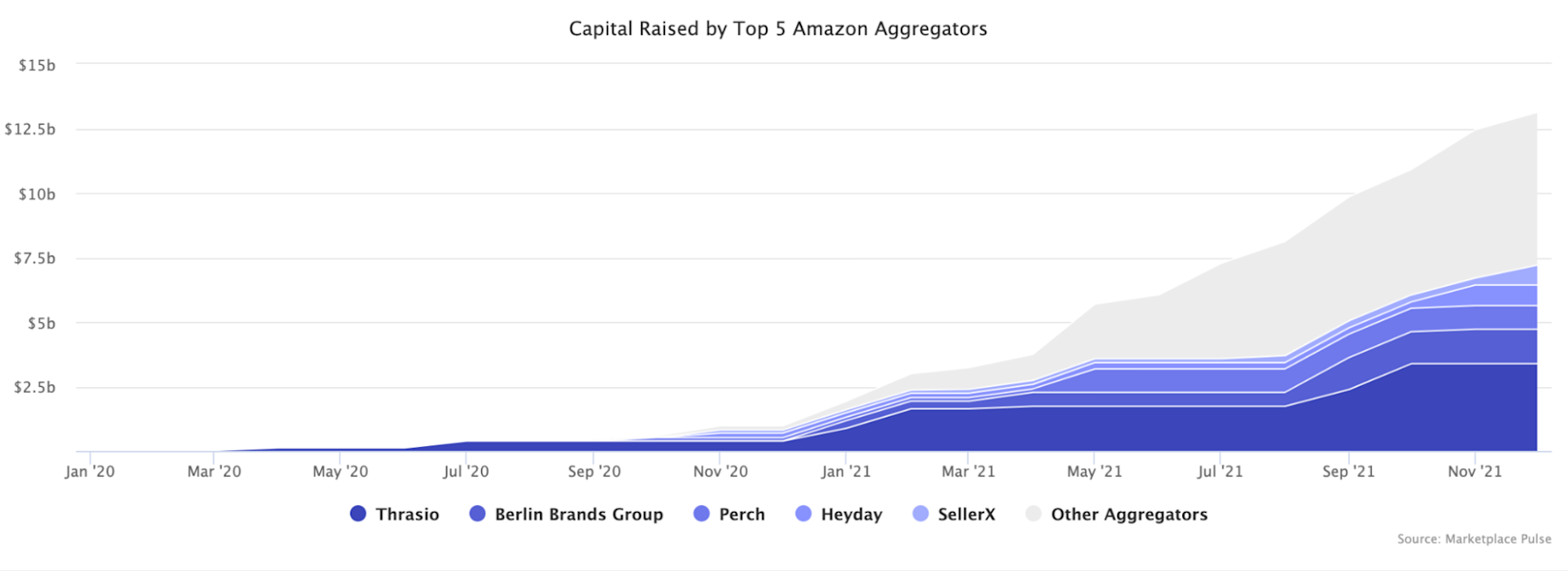
Amazon also added two more markets in 2021—Egypt and Poland—for a total of 20 global marketplaces.
2022 may bring new faces to the world of online marketplaces:
- Public and private unicorn marketplaces grew by 70% in value since January 2020, from $2.9 trillion to $5 trillion, with fashion marketplaces seeing the most substantial growth (142%).
- Macy's is also moving forward with the launch of a curated digital marketplace for its flagship brand and Bloomingdale's.
- TikTok announced TikTok Shopping with new social commerce features in 2021 and is testing a sellers app in Indonesia.
After shutting down marketplace Jet in 2020, Walmart's marketplace continues to gain momentum. For fiscal 2022, the retail giant's online sales grew 90% compared to two years ago. Other brands, like Wish, Google Shopping, and Target, promised marketplaces but underdelivered in 2021.
Top global marketplaces
Amazon
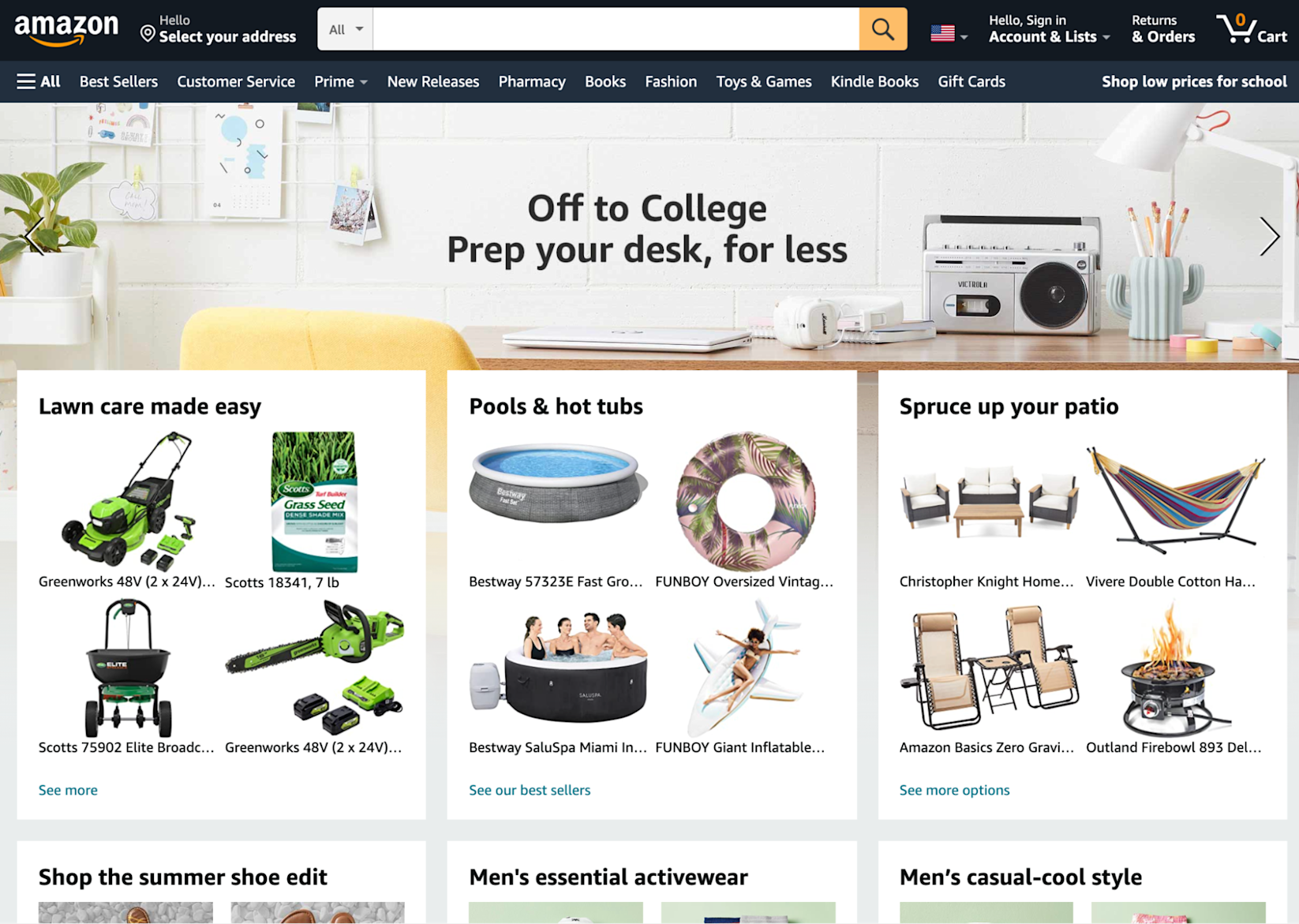
Top categories:
- Home & kitchen
- Sports & outdoors
- Toys & games
- Beauty & personal care
- Health, household & baby care
- Kitchen & dining
- Office products
- Garden & outdoor
- Tools & home improvement
- Pet supplies
The most popular online marketplace is Amazon, thanks to its powerful shipping and fulfillment abilities and its consistent shopping experience. The Amazon marketplace is also the world's second largest search engine. Incredibly, 38% of product searches take place on Amazon.
Amazon is the most-visited ecommerce marketplace, averaging more than 2.44 billion visits every month. For reference, that's more than the entire population of Africa, Europe, and North America combined.
One of the main reasons to sell on Amazon is next-level brand visibility. Many successful brands have launched on Amazon and expanded from there. Selling on Amazon can help build a sales funnel of potential customers who could eventually shop on your own site. If properly rolled out, selling on Amazon can be considered a complement—not a competition—to your direct-to-consumer website.
Some companies are reluctant to use Amazon, often due to its fees—on average, a 15% fee on every sale, but potentially anywhere from 8% to 20%. However, Amazon can help companies rank higher in Google searches, and businesses sometimes outsource their packing and mailing to Amazon.
Make sure to do your homework to see if creating an Amazon store lines up with your business goals. Consider the following:
- See if your competitors have Amazon stores and, if they do, research them.
- Meet with your team and determine how many resources you'll need.
- Estimate how much time is needed to set up and maintain the store.
- Evaluate whether you have the expertise to optimize this content for user experience and discoverability in house or if you'll need an agency partner.
Before you can create Amazon Store content, you'll need to register your brand using Amazon's Brand Registry.
Once your brand is registered, you can set up your first Amazon Store. Select your theme and start to build out your pages, much in the same way as you would your own website, making sure that the navigation is simple enough for customers to easily find what they're looking for.
After that, it's time to submit your store for Amazon's review.
With all of the above in mind, it's easy to see why Amazon is one of the most popular ecommerce markets in the world.
eBay
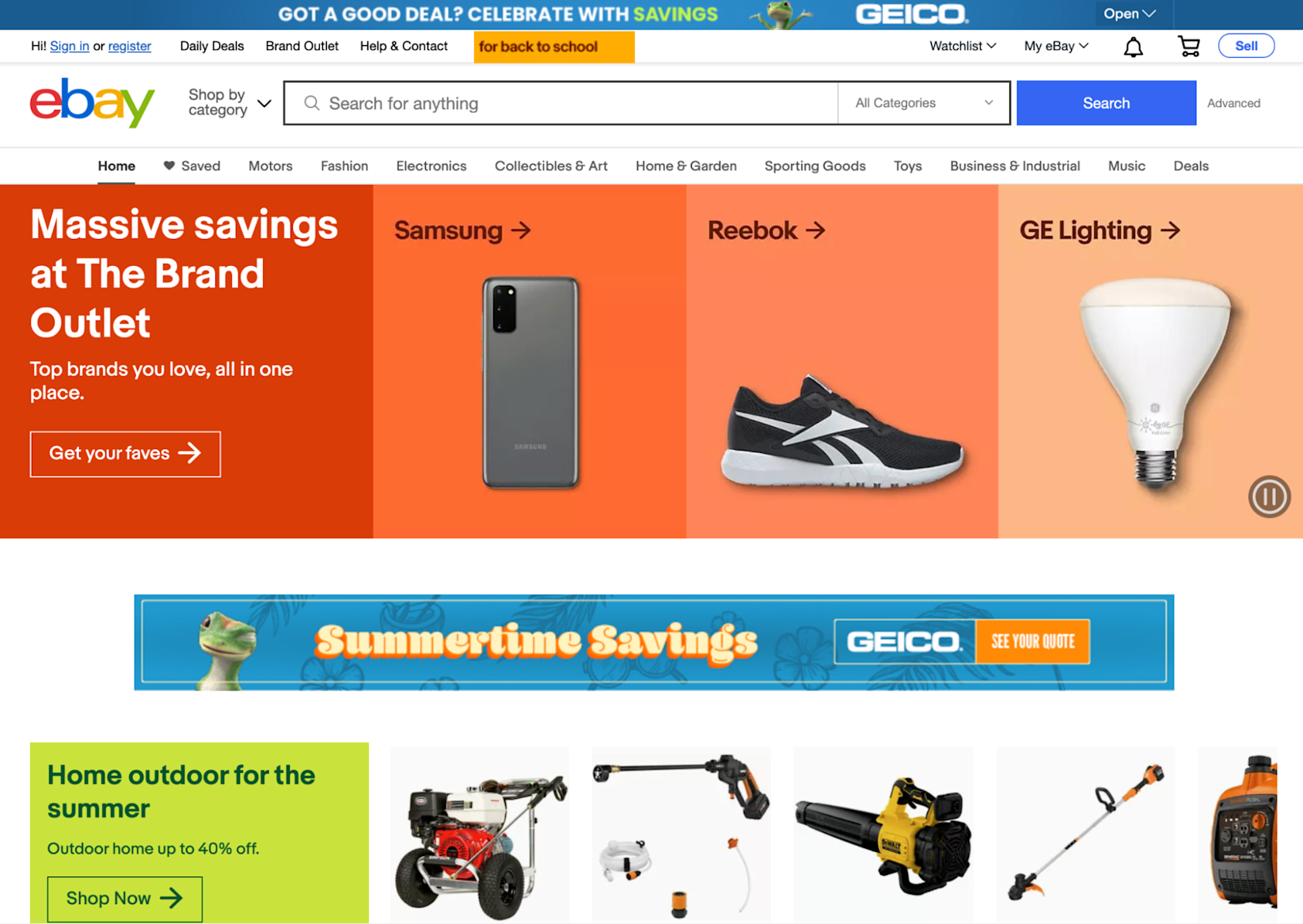
Top categories:
- Automotive
- Clothing, shoes, and accessories
- Jewelry and watches
- Home and garden
- Health and beauty
- Collectibles
- Sporting goods
- Toys and hobbies
eBay isn't just an online auction house for used items. Many of the products listed on eBay are actually new. The flexibility for retailers to sell new and used has allowed eBay to earn $2.6 billion in revenue, with 147 million active buyers in Q4 of 2021 alone.
Selling on eBay puts your merchandise in front of millions of active buyers all shopping in one place, from one catalog. It can help grow your brand footprint on eBay's global marketplaces.
With the eBay channel on Shopify (available in the US, Canada, Australia, the UK, and Germany), you can expand your reach to the 182 million users who shop the platform's fixed-price listings.
Selling on eBay has a number of benefits: it's the second most popular marketplace in the US, and shoppers don't need to find your unique store to buy your products—they just need to find your listings.
eBay is also a favorite for sellers, because it's so easy to get started with and has a number of different shipping methods, including the Global Shipping Program.
On eBay, it's important to position yourself competitively on price. Because eBay's marketplace is so large, many sellers offer the same product across a range of prices. Selection, shipping costs, and sale terms are also important, but a competitive price is still the most important factor.
To sell on eBay, there are three basic steps:
- Sign up for an eBay business selling account.
- Set up your account policies, including shipping, return, and policy preferences.
- Upload your inventory using eBay's tools or by using the Shopify integration.
With eBay, there are different levels of pricing plans, each of which helps you sell more, with reduced selling fees, "promoted listing" credits, and more. You'll need to consider a pricing structure depending on the size of your business.
JingDong (JD)
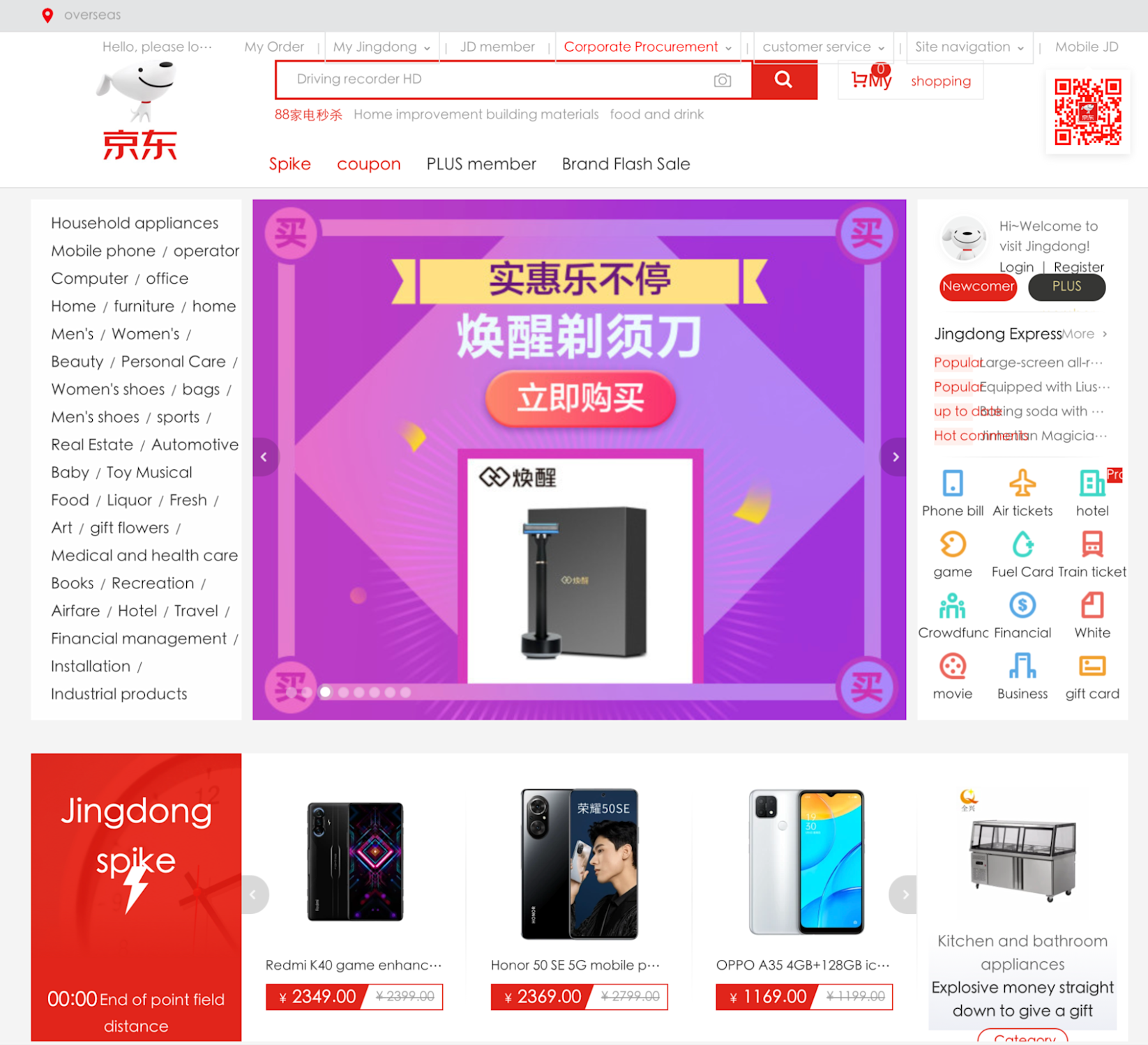
Top categories:
- Electronics & home appliances
- Automotive parts
- Food and beverages
- Fashion and apparel
- Digital products
- Cosmetics and personal care products
As a competitive leading B2C online marketplace, JD.com is a great option if you want to sell in China. JD announced a $149 billion net revenue for 2021, an increase of 27.6% from 2020. JD.com specializes in advanced technology and logistics solutions and has one of the largest fulfillment infrastructures in the world, achieving 90% of orders delivered on the same or the next day.
Entering the Chinese market has a number of hurdles:
- Complicated tax and customs requirements
- Language translation to simplified Chinese
- Pricing conversion to local currency
- Cross-border logistics
That's why we created the JD Marketplace sales channel for Shopify merchants.
Shopify's JD Marketplace channel makes it easy to sell on JD.com. Originally, the process to set up on JD.com took between six and 12 months. Now, you can get set up within four weeks, thanks to an expedited process exclusively for Shopify merchants. Once registered, you'll ship products to a JD US warehouse and JD will take it from there to the customer in China.
Walmart

Top categories:
- Computers
- Crafts
- Music
- Office
- Outdoor sports
- Tools
- Party & occasions
- Books
- Patio & garden
- Movies & TV
Walmart is now the third-most-visited online retailer in the US, with around 410 million visitors each month. In 2021, Walmart reported an over 70% increase ($43 billion) in ecommerce sales over 2020.
Walmart currently allows third-party sellers in more than 35 product categories to sell their products on its marketplace. You also don't have to be based in the US to sell on the Walmart marketplace, since 5% of its current sellers are based outside the country.
Selling on the Walmart marketplace becomes all the more essential when you consider that 48% of shoppers say they are somewhat or very likely to join Walmart+, the brand's membership program. Thus, a presence on both sites will give you a greater chance of capturing the same buyer.
Walmart also now has six ecommerce distribution centers that, when combined with in-store pickup/ship-from-store services for online orders, can meet two-day delivery expectations (in the US).
To sell on Walmart as a partner you need to follow these five steps:
- Tell Walmart about your businesses and the products you're planning to sell, as part of its application process.
- Set up your seller account once you've been approved and received a contract.
- Sign the Walmart Retailer Agreement and complete your seller profile.
- Onboard with a choice of integration methods, add your items, and test orders.
- Request for launch, where Walmart will complete a final review before you can start selling.
As part of the onboarding process, you can now connect your Shopify store with Walmart.com's Marketplace website, if approved. The app will allow you to upload your product catalog and create listings, sync inventory, and import order details for fulfillment with Shopify. To date, this is only available for brands that are based in the US.
Best online marketplaces by region
Asia-Pacific (APAC)
You've probably heard that Asia-Pacific is the region to sell in right now, and for good reason. Asia is currently the most populated region in the world, with over four billion people, and is expected to grow further still, to 4.3 billion by 2025.
Growth potential is concentrated in Indonesia, Vietnam, and Thailand. But it's China that fuels over 52% of global ecommerce sales and likely will continue to dominate until at least 2025.
Digitalization transformed APAC into a purchasing powerhouse and saved the region from much of the economic damage other countries experienced due to the pandemic.
Alibaba

As the leading online commerce provider in China, Alibaba is a platform you'll want to give serious consideration. As a whole, the Alibaba Group boasts over 1.24 billion annual active consumers and reported revenue growth of 29% year over year in 2021.
As a business to business (B2B) manufacturer and wholesale supplier, Alibaba.com provides the foundation for many businesses. So if your business is about selling products to other businesses (which don't have to be limited to China), look no further than Alibaba.com.
To start selling with Alibaba, you'll just need to fill out a simple form to create an account. The rest is up to you.
AliExpress
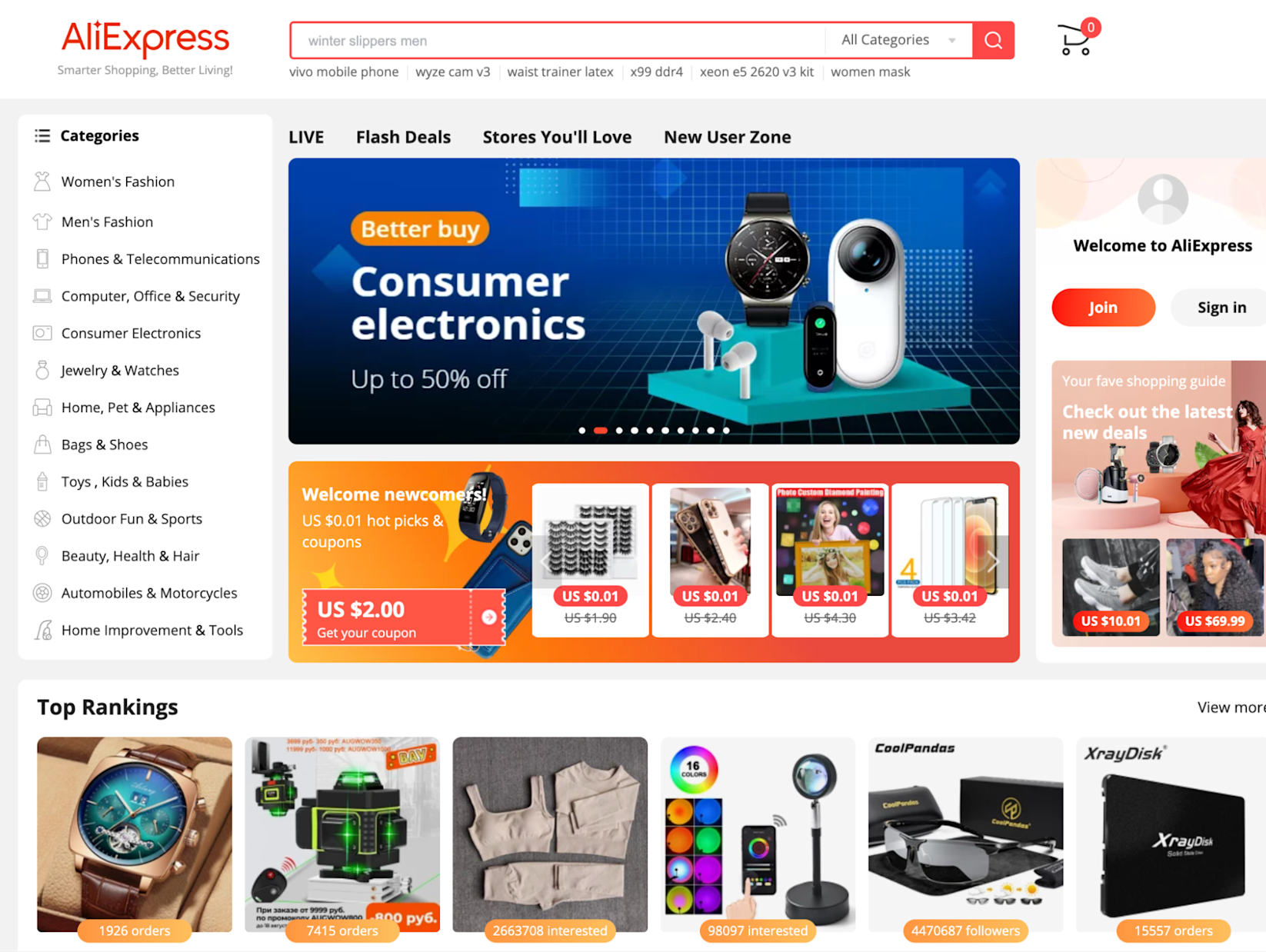
AliExpress is a subsidiary of the Alibaba Group and one of its B2C online marketplaces, so its stats fall under those in the previous section. On its own, AliExpress pulls in over 500 million website visits a month and has over 600 million downloads of its mobile app.
What makes AliExpress a great option for many businesses is its localization—the platform is available in 18 languages in 230 countries and regions. It's a common marketplace for dropshipping companies because many suppliers ship direct to consumer for affordable fees.
Selling on AliExpress is as easy as selling on many other platforms: create an account, submit your business information, then submit your application. After that, you can personalize your store and start selling.
Although Amazon might be the largest and most-well known global marketplace, AliExpress is an underutilized alternative which still gets over 500 million visitors every month."
— Jorge Vivar, Creative Director at CBD retailer, Mode
Taobao
Formed in 2003 by Jack Ma, Taobao reported a gross merchandise volume of 3.39 trillion yuan (almost $523 billion). What separates Taobao from AliExpress and Tmall (see below) is that its business model is primarily consumer to consumer (C2C)—think of it as the eBay of China. As of April 2022, Taobao was ranked 12th in global internet engagement.
Tmall Global
Tmall Global is the direct-to-consumer (D2C) counterpart to Taobao. Together, these two retail sales giants make up 58.2% of China's ecommerce market share. Tmall Global is positioned as Alibaba's "cross-border" site—a way for sellers to build virtual storefronts for Chinese consumers without needing Chinese operations.
XiaoHongShu
Another online marketplace from China is XiaoHongShu (otherwise known as RED, or Little Red Book). XiaoHongShu has a very different approach in that it also doubles as a social media platform. It uses influencer marketing and reviews to fuel ecommerce sales. The platform is currently valued at $5 billion, and in July 2020 it raked in eight billion views in a single day.
GraysOnline
Another online marketplace of note is Grays, which is the largest industrial, auto, and commercial ecommerce business in Australasia. Analysts expect it to achieve $871.6 million in gross transactions through its selling platform, with $125.7 million in revenue in 2021.
Flipkart
Flipkart is an ecommerce company based in Bengaluru, India, and was acquired by Walmart in 2018. The company was founded by previous Amazon employees in October 2007, launching a proprietary product line called DigiFlip that included laptop bags and tablets, and has since expanded into other product categories like furniture, grocery, travel, and beauty.
Flipkart is a close competitor to Amazon, generating 433 billion Indian rupees ($5.7 billion) in 2021. Top categories include electronics, home and kitchen, fashion, books, and health and beauty products.
Rakuten
Rakuten saw a 20.5% increase in gross transaction value (GTV) in 2021. Its customer base is made up of 1.6 billion members, and products include electronics, fashion, and pet supplies.
In order to sell on Rakuten, merchants must apply and be approved. Brands can customize storefronts, which can help create your own brand identity on the platform and attract customers.
US- and Japan-based brands can also use Shopify's Rakuten Ichiba app to start selling in Japan, while easily translating Japanese and managing everything within Shopify.
Europe
The European Union is the third-largest market in the world and, according to Statista, gross merchandise revenue is expected to show an annual growth rate of 5.43% from 2021 to 2025, resulting in a projected market volume of $655.6 billion by the end of that period.
For international sellers, the situation is complicated by Brexit and new EU tax rules. If you're looking to expand into this region, be sure to read about the consequences of Brexit beforehand.
Not On The High Street (NOTHS)
Similar to Etsy in terms of handcrafted goods, Not On The High Street specializes in hard-to-find products and gifts. It boasts a brand awareness of 80% in the UK, with over 2.8 million customers in 2020.
NOTHS reported a 2020 annual revenue of 37.1 million British pounds ($51.6 million) and says its best performing product categories were jewelry, home, stationery, and parties.
Otto
You may not have heard of it outside of Europe, but Otto GmbH is one of the world's largest ecommerce companies, and founder of the delivery service Hermes. Otto originally specialized in mail order but now sells a multitude of products, much like Amazon and eBay.
In February 2021, Otto reported online revenues of around 10 billion euros ($11.8 billion), a global increase of about 23% (22% of which was from Germany).
Yatego
In terms of German-speaking online marketplaces, Yatego is also one of the top sites for traders to sell their products—more than 7,700 dealers use Yatego as an additional sales channel.
Being a German-language site naturally means it has smaller revenue opportunities than multilingual sites, but it still managed to generate $1.65 million with only 10 employees.
Zalando
Zalando originated in Germany, so it's no surprise that it's the country's highest ranking online marketplace for fashion. In its first-quarter financial results for 2021, Zalando reported that nearly half of its revenue from fashion sales came from Germany alone (921 million euros).
Bol
For domestic online marketplaces, bol.com serves as the Netherlands' favorite, reporting net sales of $1.3 billion in 2019. More recently, in 2020, that net sales figure significantly increased, to $2.1 billion, showing the positive impact of the pandemic.
Bol.com currently serves over 10 million customers across the Netherlands and Belgium and has over 2.5 million visits per day on its platform.
Wehkamp
For a Bol alternative in the domestic all-round online market, you can turn to Wehkamp, who's dominant product category is fashion, followed by furniture.
In 2020, Wehkamp generated $874.2 million in net sales, almost exclusively from the Netherlands. In July 2021, it hit an estimated 6.86 million visits on its website.
North America
Best Buy
Another marketplace you can consider selling on is Best Buy. You might think you have to be a major brand to sell there, but even a small business can apply to become an online seller. Best Buy's domestic revenue in the 2021 fiscal year was $43.3 billion.
You might also be surprised to know that Best Buy came after Amazon (and before Apple) in the list of consumer electronics retailers with the largest amount of sales in North America.
Although the application process isn't transparent (therefore it's unclear how difficult it is to get approved) these numbers are hard to ignore and, alongside the Best Buy brand association, make it a significant marketplace for your business.
Etsy
Last on our list of popular North American ecommerce sites is Etsy. Esty mostly serves the arts and crafts community, specializing in handmade, vintage, and collector's items.
When shopping on Etsy, you're unlikely to find the same product listings anywhere else on the web (except maybe the seller's own online store). As such, it works quite differently from the other ecommerce platforms we have looked at so far. Etsy brought in over $717 million in 2021, up 16.2% year over year.
So if you're a craft-based small business, it makes a lot of sense to list products on Etsy—which is very easy to do (just create an account and start listing). One caveat is that Etsy charges you a listing fee, but overall, these fees are lower than some of the other marketplaces we've discussed.
Latin America
The Latin America region is one of the fastest-growing ecommerce markets in the world. The pandemic had a significant impact on its retail industry. Retail ecommerce sales for the region grew 36.7% in 2020, reaching $84.95 billion, nearly three times more than eMarketer's forecast in 2019.
International retailers have plenty of economic powerhouses like Argentina, Mexico, and Brazil to break into. Mercado Libre is the number one marketplace in Latin America and one of the top 10 visited ecommerce websites in the world.
Mercado Libre Mexico
Mercado Libre is a massive online retailer and payments ecosystem in Mexico. Founded in 1999, Mercado Libre has become Amazon's largest competitor in the country. According to its Q4 2021 investor deck, the online marketplace generated $2.1 billion in ecommerce revenue, selling over 287 million items at a gross merchandise value of $8 billion.
An all-around online store, Mercado Libre welcomes 106.5 million visits per month in a country with only 20 million online buyers. It sells products in 150+ categories, including smartphones, home and garden, sporting goods, fashion, and electronics and accessories.
Amazon Mexico
Amazon Mexico was officially launched in 2013. By 2019, it had accumulated more than 50 million users and delivered to more than 25 cities per day. Today, Amazon is the second-largest e-retailer in Mexico, with a 11.6% market share.
Amazon.com.mx more than $2.6 billion in sales in 2021. Amazon Mexico generates most of its ecommerce net sales from its electronics and media category.
Americanas
Lojas Americanas is a retail chain founded in 1929 in Rio de Janeiro. In 2020 its net sales peaked at a record high of over 20 billion Brazilian reals ($3.82 billion). Its main categories are toys, hobbies, and DIY-related products.
Alongside these impressive sales figures, the americanas.com.br website is estimated to receive 108.2 million visits per month, more than 99% of which are visitors from Brazil.
Casas Bahia
Where many online marketplaces are generalized, Casas Bahia specializes in furniture and home appliances. By targeting this specific niche, it has enabled itself to become the go-to place for Brazilian shoppers in this category.
In 2021, its estimated net sales figure reached $2.18 billion, and its website traffic hit 80.72 million visits in July 2021.
Frávega
Frávega is an Argentine marketplace focused on national sales. It does over $181 million in revenue per year with an extensive product range. Its most popular category is furniture and appliances, followed by electronics and media and toys and hobby.
Benefits of selling through global marketplaces
Some benefits of selling on marketplaces include:
Gaining access to millions of customers. Where do customers often go to start their shopping? Marketplaces. Listing your items on eBay, for example, gives you access to a customer base of 187 million. Walmart now sees 410.5 million monthly visits and Amazon has over 2.4 billion visits per month.
Visibility and brand awareness. Marketplaces can also help you access new audiences. One concern of brands is that people will buy their products on marketplaces instead of on their own sites. The fact is, without visibility in marketplaces, you may not get many of those customers in the first place. The next move could be to build a strong relationship with new customers and help transition them from a marketplace to your own website.
Gaining trust. When you sell on a marketplace you are also the beneficiary of its marketing and brand building. Consumers tend to trust marketplaces, which automatically help your business have a built-in established level of trust.
Testing ground. Do you want to know what people are willing to spend on a product? Do you have a product surplus or want to introduce a new product? Use a marketplace instead of your own store to test out what works and what doesn't.
Going global. Most marketplaces operate internationally. When selling your products on a country-specific marketplace you can expand your reach to other countries with minimal effort.
Tips for selling on global marketplaces
1. Choose the right marketplace for your brand
As tempting as it might be to list your products on every single marketplace, you want to focus only on platforms that are a good fit for your products. Each marketplace has its own nuances, rules, and audience.
Some might take a commission on every sale. Others might charge you a listing fee. Either way, you'll need to weigh the costs and benefits of getting access to a certain marketplace's customers.
When I think of my consumer behavior, I tend to like marketplaces. I don't have to go to five different stores to buy five different categories of things."
—Patrick Coddou, Founder of direct-to-consumer razor startup Supply
Here are a few characteristics of online marketplaces that will help you narrow down your choices:
Products. Some marketplace retailers may be more niche than others or may not allow the sale of products in particular categories (like medical devices). Research your potential marketplaces to see if your product can sell there.
Fees. It's not just the selling and transaction fees and the commission structure you'll need to contend with. Remember to check out shipping costs (if they're not included), as well as any chargeback or refund fees.
Customer location. If you're primarily looking to sell in the United States, it makes sense to use a marketplace US customers are familiar with, such as Amazon or eBay. If you're looking to sell to customers in Asian markets, then you'd be better served by Alibaba or Tmall.
Competition. While listing on a marketplace should help you get ahead of those who don't (remember: customers do their initial product searches on marketplaces), you're up against hundreds, sometimes thousands, of other vendors.
Consider whether you want to search for a more niche marketplace before going head-to-head against other vendors on big marketplaces.
With this in mind, you should be able to have a better idea of what you're looking for in an online marketplace.
2. Use advertising strategies
Advertising on marketplaces like Amazon is on the rise. Some 57% of ecommerce marketplace operators use display advertising to engage buyers through marketplaces. Each platform has its own rules and guidelines for advertising, but if you plan to pay for placement, prepare by doing the following:
- Prep inventory. Running marketplace ads can lead to a quick boost in sales. Set up an automated inventory management system to keep stock levels balanced. Make sure your fulfillment center is staffed properly or you're working with a 3PL.
- Create a pricing strategy. You'll be competing heavily on price when advertising in a marketplace. Marketplaces often run on a pay-per-click model. Costs vary widely.
- Craft product content that's informational, helpful, and customer friendly.
It's necessary to consider profitability trade-off. Conduct a cost-benefit analysis of the addressable market that ads will reach on a specific marketplace. Understanding early the level of margin you'll accept can help maximize ad spend.
3. Optimize product listings
Once you have a marketplace to display your products, treat product listings like your own website. Showcase your brand and introduce products how you want. If you're selling on multiple marketplaces, consider a management platform to manage everything at once.
Experiment with product titles and descriptions for specific search queries. Shoppers will see your title first before deciding to click on your listing or not. Each marketplace has its own ranking principles and SEO. Test and experiment with what works best to show up for select queries.
Use search engine optimization for each platform's search feature. For Etsy, we use several tools to identify keywords and tags that help people find us. It took us months and months to figure out what works, but now we get lots of organic traffic on the platform and make good money there."
—George Pitchkhadze, CMO of Keyzar Jewelry
4. Offer an assortment of products
Marketplace algorithms boost high-performing products to the top of search engines. Products that get many great reviews and get purchased repeatedly are more likely to show up for shoppers. Your offerings also shape consumer perceptions of your brand and your marketplace performance. Consider listing top-performing products from your store versus, say, a brand new style that has zero traction.
5. Create a good customer experience
"Give global customers the same visibility and courtesies you would to local customers," says Shelly Socol, founder of 1 Rockwell, a lead global ecommerce agency. While marketplaces may restrict certain elements like customer identities and branding opportunities, you can still create a good shopping experience.
Socol recommends:
- Offering pricing in shoppers' home currency
- Offering human-curated translations
- Showing total landed cost expectations (including duties and taxes)
- Showing shipping and delivery expectations.
Start selling globally today
As you can see, there is no shortage of online marketplaces for ecommerce brands to sell on. These websites can help you expand your brand awareness, reach new markets, and drive sales online. But expanding internationally takes planning and understanding of different customs and cultures.
Source: https://www.shopify.com/enterprise/global-ecommerce-marketplace